欧博'The Last Repair Shop' Filmmakers Shar
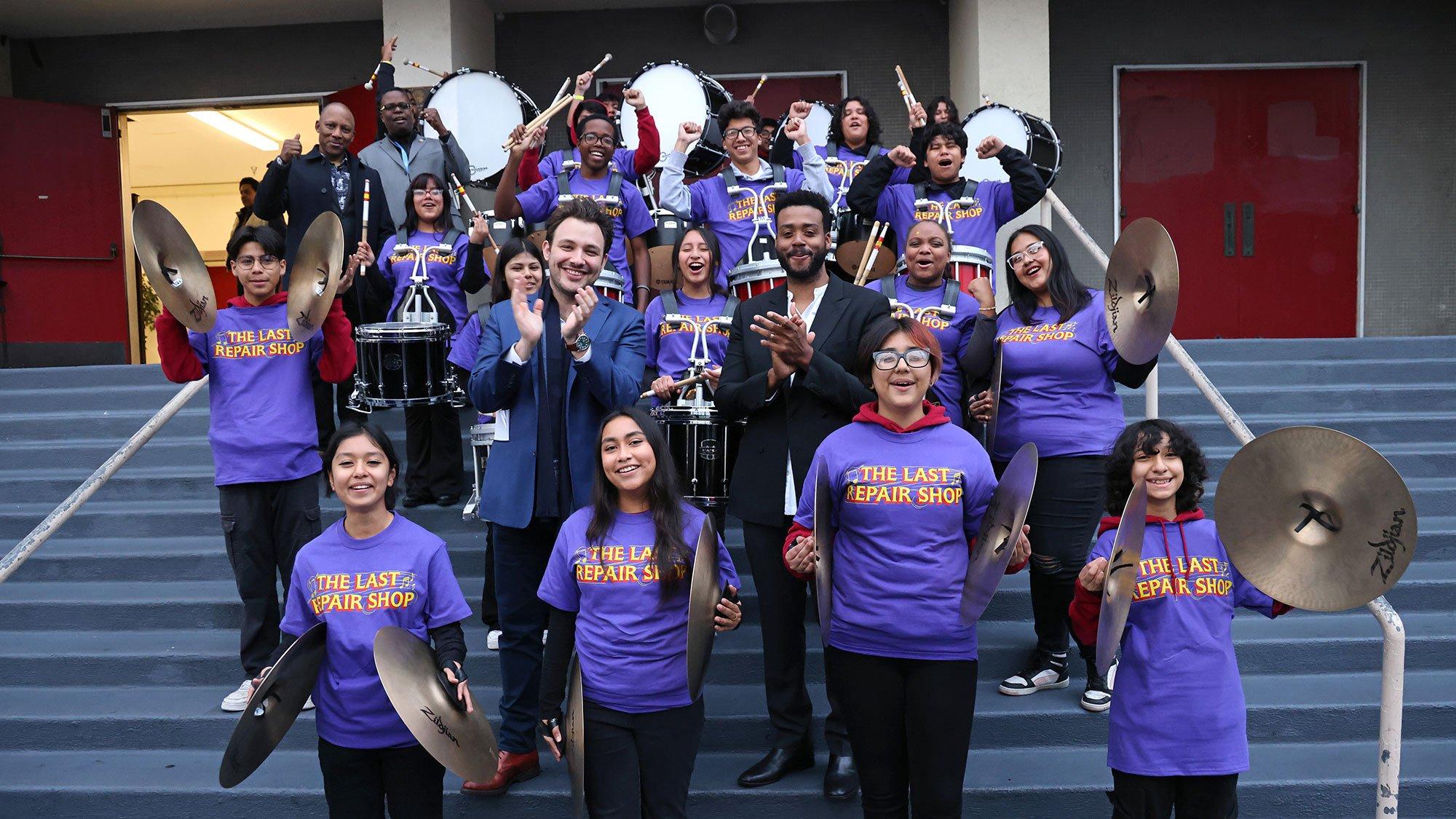
Filmmakers Ben Proudfoot and Kris Bowers pose with LAUSD band high school participants.
Photo: David Livingston/Getty Images
Interview
'The Last Repair Shop' Filmmakers Share Behind-The-Scenes Stories About Oscar-Winning DocumentaryThe L.A. Unified School District's Musical Instrument Repair Shop is the subject of 'The Last Repair Shop,' which won the 2024 Oscar for Documentary Short Film. The filmmakers talk about creating the documentary short and the impact of music education.
Christopher Guly
|GRAMMYs/Mar 5, 2024 - 02:27 pm
Editor’s Note: Updated Sunday, March 10, to reflect the results of the 96th Academy Awards.
Since it opened its doors in 1959, a repair shop in a downtown L.A. warehouse has been making music accessible for kids.
The facility is owned by the Los Angeles Unified School District (LAUSD) and has restored many of the 130,000 musical instruments in circulation for more than 500,000 students. It’s one of the last publicly funded services of its kind in the United States and provides repairs at no cost to students or their families.
The LAUSD’s Musical Instrument Repair shop has largely operated under the radar until Academy Award-winning filmmaker Ben Proudfoot and GRAMMY-nominated pianist and composer Kris Bowers shone a cinematic light on it. Their film, The Last Repair Shop, won the Oscar for Documentary Short Filmat the 2024 Academy Awards.
The 40-minute documentary profiles four of the shop’s 12 technicians. Each is responsible for repairing a different class of instrument: brass, woodwinds, strings, and pianos. In touching interviews, the technicians share their stories and how the work has transformed their own lives.
Proudfoot, the 33-year-old founder and CEO of L.A.-based Breakwater Studios Ltd., tells GRAMMY.com that the "magic" of these personal stories created a unique narrative. Much like the instruments they repair, Proudfoot says the technicians were once "broken" and were "restored by music in some way."
In the film, guitarist Dana Atkinson, who works in the strings department, compares detecting a buzz in a cello with the process of coming out as gay.
"I thought I was broken," Atkinson says in the film, crediting his musician mother for teaching him that "music is like swimming. The rhythm is constantly in the moment, and if you stop, there is no music. Whatever you do, don’t stop."
Paty Moreno left her native Mexico to pursue the American dream more than two decades ago, but found herself struggling to survive in L.A. as a single mother with two young children. "We were so poor. Sometimes, we didn’t have food," she recalls tearfully in the documentary.
2024 Oscars: Watch Performances & Highlights
2024 Oscars: GRAMMY Winners On The Red Carpet
Mar 10, 2024
Watch Becky G Perform "The Fire Inside"
Mar 11, 2024
Driven by her mother’s words to her as a child that she could "do anything in life," Moreno took a complicated instrument-repair technician test to work in the brass section in the shop, which at the time in the early 2000s, had only ever had male employees.
Woodwind technician Duane Michaels shares in the film that he was often bullied as a child, but found solace in the 1935 film, The Bride of Frankenstein. In one scene, a soothing violin played by a blind man brings tears to the monster’s eyes. Michaels was immediately bitten by the "fiddle bug," convinced his mother to buy him a $20 violin, and went on to help form a hillbilly-bluegrass band, called the Bodie Mountain Express, which opened for Elvis Presley at his 1975 New Year’s Eve concert.
That $20 instrument set Michaels on a life path, and he recognizes the power of music education to do the same for others. "Kids have a chance to play instruments that they can’t afford," he says in the film. "That one instrument can change their whole life."
*Duane Michaels*
The Last Repair Shop took four years to complete, and became deeply personal for 34-year-old Bowers, a former LAUSD student. The pianos Bowers played during his elementary and middle school education were tuned by shop supervisor Steve Bagmanyan — another of the film's subjects.
Bagmanyan remembers falling in love with the piano as an ethnic Armenian boy growing up in then-Soviet Republic, Azerbaijan. He fled to the U.S. with his mother in the late 1980s during the First Nagorno-Karabakh War in which his father was killed.
Bowers says that including Bagmanyan in the film became an expression of gratitude for “someone who did directly impact me.”
“I was able to say thank you,” recalls L.A.-born Bowers. “It was very special.”
The end result of the restorative work provided by Bagmanyan and the other shop technicians has a more far-reaching effect, according to Proudfoot. "Learning how to play a musical instrument has a profound impact on who you are that makes not just good musicians, but good citizens," he says.
Bowers also spent about 45 minutes interviewing student musicians, each of whom details what their instrument means to them.
Ismerai Calcaneo talks about how music "changed" her life when she started playing saxophone in school at the age of 9. The instrument helped her "be more disciplined."
"I have to be on time, I have to practice, I have to look good — it helps me focus more," she says in the film. "When I am feeling tense, when I’m feeling sad or angry, the saxophone calms me down."
For Amanda Nova, playing the piano before an audience is a source of empowerment and a way to reduce stress. "I’m scared that I might not find a purpose in life," she says. "But once I’m on stage, all that tension goes away."
Bowers hopes that the stories in The Last Repair Shop shine a light on "how much music education can do beyond create incredible musicians." He tells GRAMMY.com that being in a school jazz band had a significant impact on his life.
"Listening in the jazz context is such a deep form of communication, and it definitely translates into how I listen in my life outside music," says Bowers, who directed the 2020 Oscar-nominated documentary short, A Concerto is a Conversation, with Proudfoot.
"When it comes to young people, we’re very clear on the idea of what sports can do when it comes to discipline, but not everybody wants to be an athlete," he says. "If we’re able to understand the value of sports in helping them with other aspects of their lives, I really feel that the same argument can be made for music."
Proudfoot echoes Bowers’ sentiment.
Music "teaches you how to listen, how to play in harmony and collaborate," he says, adding that, hopefully, the experience "provides you with a reasonable example of having discipline and learning how to conquer a complex thing, which is a useful skill in life."
Both Bowers and Proudfoot hope the film inspires people to invest in music education.
Their film certainly seemed to strike a chord. On Feb. 20, the LAUSD Education Foundation launched a $15-million capital campaign called The Last Repair Shop Fund to support the restoration operation.
As the final moments of The Last Repair Shop, an orchestra featuring LAUSD alumni and current students perform a piece composed over a weekend by Bowers, who also penned the score for the movie-musical, The Color Purple, which was shortlisted for best score at this year’s Academy Awards). The scene sweetly threads the impact of music education on youth and adults.
The dedicated technicians toiling away in a nondescript shop also have high hopes for the musicians whose instruments they care for.
“In a way, you can feel like you’re fixing an instrument for a future GRAMMY winner,” says Michaels. “If you want to kind of dream a little bit."
Virginia's Annie Ray To Be Honored With 2024 Music Educator Award
Read More
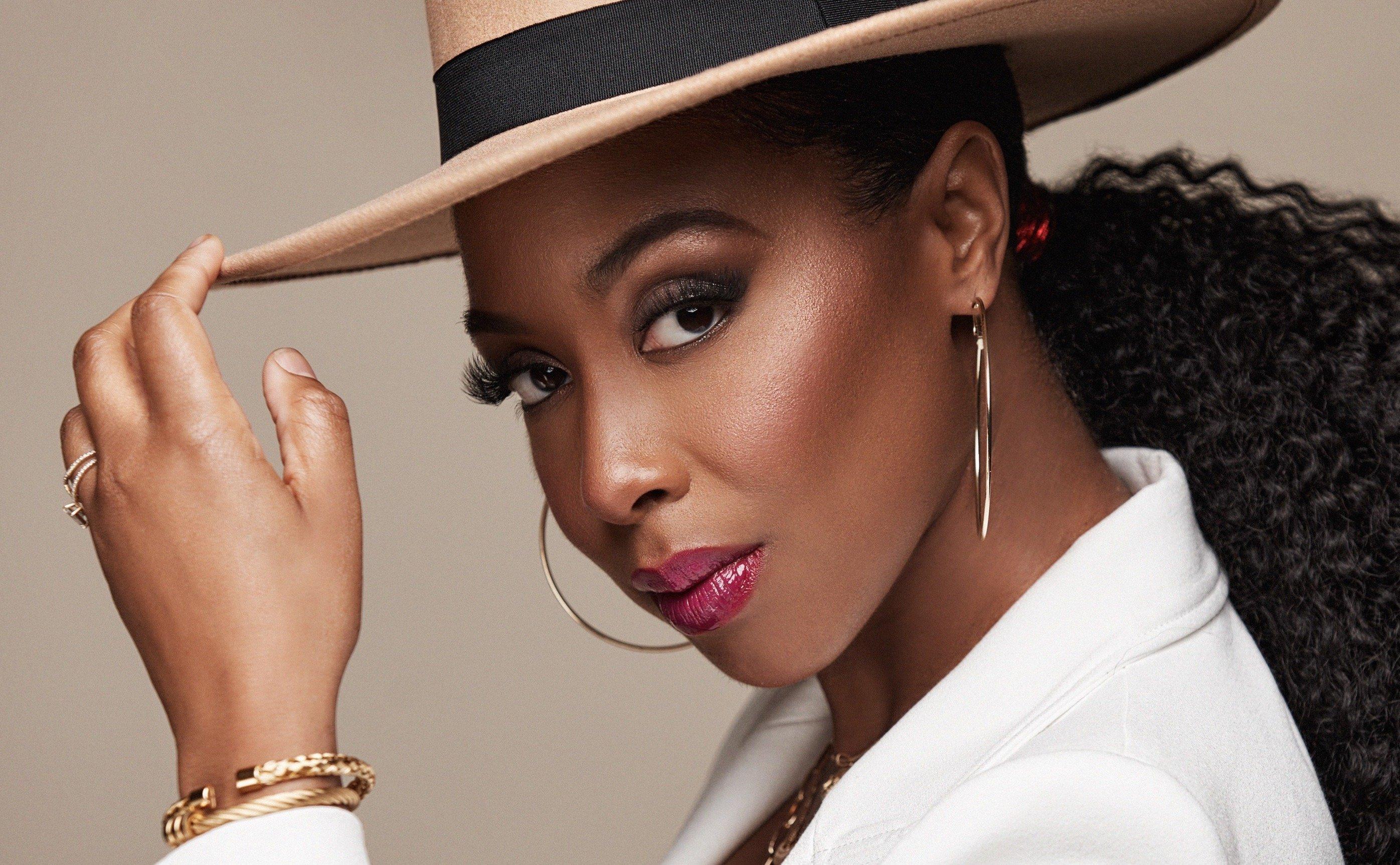
Carolyn Malachi
Photo: Roy Cox
Interview
Howard University Professor Carolyn Malachi On The Importance Of Music Education & Discovering What Moves You As An ArtistTo close out Music In Our Schools Month, Howard University instructor and GRAMMY-nominated artist Carolyn Malachi details the need for music education in schools across the nation.
D. Mariah
|GRAMMYs/Mar 31, 2025 - 11:08 pm
For 40 years and counting, the National Association for Music Education (NAfME) has celebrated music education and its educators every March for Music In Our Schools Month. However, this year is different, following President Donald Trump's executive order to close the Department of Education. Although the long-term effects are unclear, it poses a viable threat to the future of arts education programs in the United States, which have already been severely underfunded for decades.
While it may be a confusing time for many educators, in the eyes of Howard University professor Carolyn Malachi, it also presents an opportunity to show just how crucial arts education programs are.
"Music education, especially the technical side, has never been more important," Malachi — a GRAMMY-nominated R&B singer, producer and engineer who has taught at Howard since 2018 — stresses to GRAMMY.com. "The skills students develop in audio production and engineering extend beyond music into film, gaming and emerging tech. The possibilities are endless."
As a music educator, Malachi has used her voice to advocate and make more space for underrepresented groups interested in the technical side of music. Currently, she serves as the Producing & Engineering co-chair for The Recording Academy's Washington, D.C. Chapter and teaches courses in the GRAMMY GO creator-to-creator learning platform. She has also hosted guest lectures and workshops and participated in panels at the Smithsonian's Natural History Museum ("Digital Futurism"), the Audio Engineering Society ("Equity Learning Series: Immersive and Inclusive — A Discussion of Representation in Immersive Audio") and more.
For Malachi, it all started with her great-grandfather, John Malachi; a recipient of the Benny Golson Jazz Masters Award and former educator at Howard, he taught her the joy of music. She later became a Fulbright Scholar at Shepherd University, studying music production and performing internationally, including the United Kingdom, Japan, South Africa, and St. Lucia. On the heels of her graduation, Malachi released her debut project, Lions, Fires & Squares, which earned her a GRAMMY nomination in 2011 for Best Urban/Alternative Performance ("Orion").
Since then, Malachi has earned her master's degree in Audio Technology from American University and received an honorary doctorate from her undergraduate alma mater. And just like her great-grandfather did decades earlier, Malachi is now ready to pass the torch to another generation of rising artists, teaching students how to step into their musicality in audio production courses as a full-time professor.
Rounding out Music In Our Schools Month, Malachi sat down with GRAMMY.com to explain why music education is imperative to artistic development, how the instructors in her life inspired her to pursue music, and how she continues to advocate for her students during tumultuous times in the United States.
Since you're both an educator and an artist yourself, why do you think music education is important?
Music education isn't just about music. It builds critical thinking, problem-solving and collaboration skills.
I teach in the Cathy Hughes School of Communication. In my Music & Media music production class, students learn how to inform and create the emotional impact of media narrative developed by our film, television and advertising students. With the emergence of new podcasts, documentaries, narrative films, and other media, it's music that helps us feel the depth of the moment and make sense of it all.
How do you advocate for your students in and outside of the classroom?
Though I teach production, we spend a significant time developing relevant entrepreneurial skills. We talk about the importance of owning the means of production, developing healthy relationships with experienced professionals who can help shape their careers, and that emerging technologies and new knowledge will always provide an impetus to grow.
I also push for opportunity, whether it's bringing guest speakers, setting up collaborations or making sure they walk away with something tangible for their portfolios. Dr. Leslie Gaston-Bird visited us last summer and taught a weeks-long workshop in Dolby Atmos. GRAMMY Award-winning engineer Brandie Lane opened up her Pro Tools session and walked through her process. Cayman Kelly and Brian Freeland of SiriusXM shared their production and engineering processes and fielded students' industry questions. Emily Lazar — another GRAMMY Award-winning engineer — her nonprofit, We Are Moving the Needle, donated mics.
When the music community, especially my GRAMMY family, shows up, my students feel seen and their confidence grows.
View this post on Instagram
A post shared by Carolyn Malachi (@carolynmalachi)
Despite threats on music education, what keeps you going as an educator?
The students. Seeing them develop their craft, create meaningful work and carve out their own paths. That's what keeps me motivated. Music education isn't just about preserving tradition — it's about building what's next.
What were some of the most influential parts of your childhood education that taught you the importance of a passionate teacher — and inspired you to become an educator yourself?
The best teacher I had didn't just teach. They made me curious. They encouraged experimentation, challenged me to think critically and gave me space to grow. That is the kind of energy I try to bring into my own classroom.
You received a Fulbright grant at the start of your career to support research and training in foreign countries. How did that experience inform your decision to become a professor at Howard University?
It reinforced that music is global. It's culture, technology and storytelling all wrapped into one. Howard University felt like the perfect place to continue that work.
What drew you to Howard specifically?
Howard University has a legacy of musical excellence and innovation. My great-grandfather, John Malachi, taught in the jazz department, so I grew up knowing the caliber of artists and scholars who came through the school. I wanted to be a part of that tradition while pushing forward new opportunities in audio production and engineering because these skills are widely applicable.
What has been the most meaningful moment of your career in music education? And what are some of the things your students have taught you as a professor?
Every semester is special. This semester, SiriusXM and Howard University have a new podcast collaboration called "Sound and Scholarship." The project is in conjunction with Howard's new hip-hop minor. My Advanced Audio Production students — seniors who have been with me since their freshman year — are handling post-production, while my Music in Media students, mostly sophomores, are producing original music for the podcast's inaugural season.
Watching the two classes work together is truly amazing. There is collaboration and mentorship, not to mention a few dozen previously unknown plug-ins to learn. As a professor, I've learned that students will work toward the standards I set. So, I do my best to set the bar high. However high you're thinking, just know that it's probably higher than that.
Loading...
For GRAMMY GO, you teach a course called "Music Production: Crafting an Award-Worthy Song." Since award-worthy is subjective, how did you discover and define what award-worthiness meant to you?
The GRAMMY GO course specialization is a game changer. With the three courses, it comes down to honoring genre-specific creative intention, technical excellence and emotional impact. A great song sounds good. It feels good. And every music person will take their own journey to that ideal state.
Why do you think accessible courses like GRAMMY GO are necessary?
They connect students directly to the industry. It's one thing to learn in a classroom, but it's another to work with the candid guidance of professionals, get feedback from peers and understand how things actually operate.
Learn More: How The Recording Academy's GRAMMY GO Is Building A Global Online Learning Community & Elevating The Creative Class
In 2011, you received your first GRAMMY nomination. How did your career shift after the nod? More than a decade later, can you recall what doors opened after you heard the news?
The nomination was huge. It expanded my network, led to collaborations and validated years of hard work. But more than anything, it reinforced that the real goal isn't recognition — it's continuing to do the work at the highest level.
Latest News & Exclusive Videos
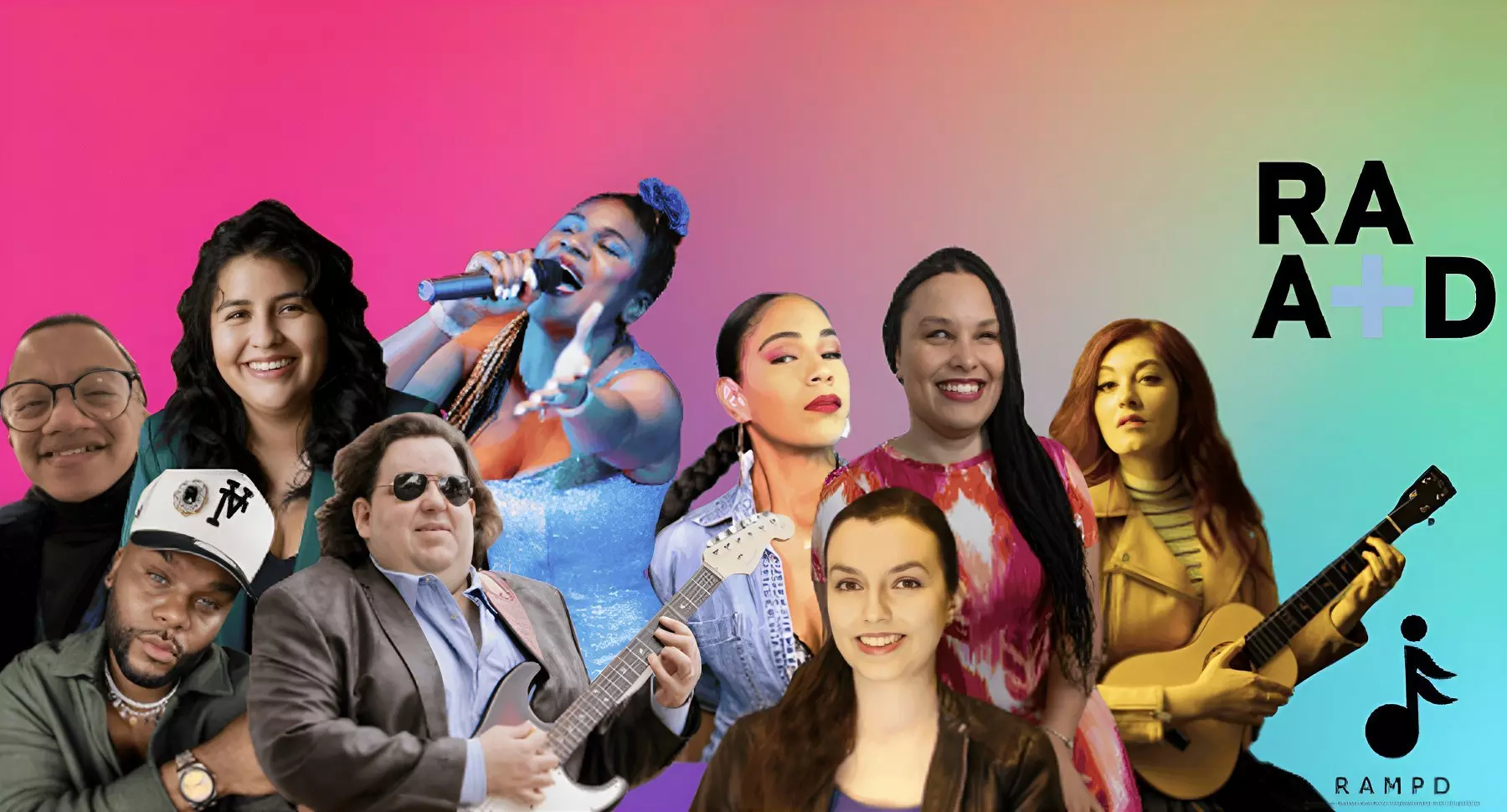
Academy Leaders On Disability Inclusivity In Music
Jul 22, 2025
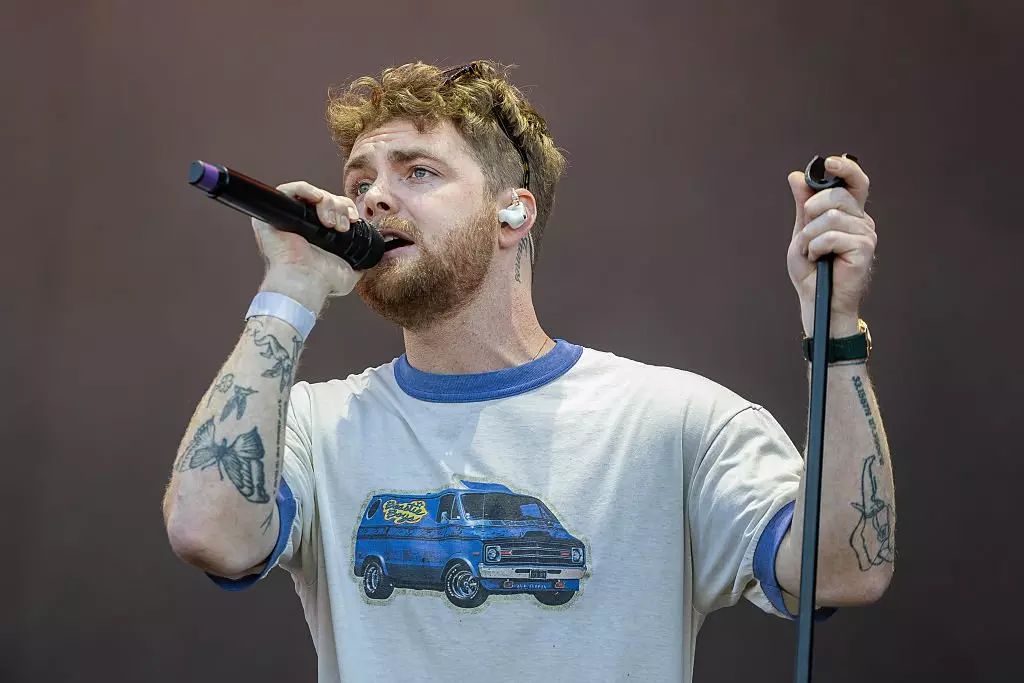
Get To Know "Ordinary" Singer Alex Warren
Jul 21, 2025
Read More
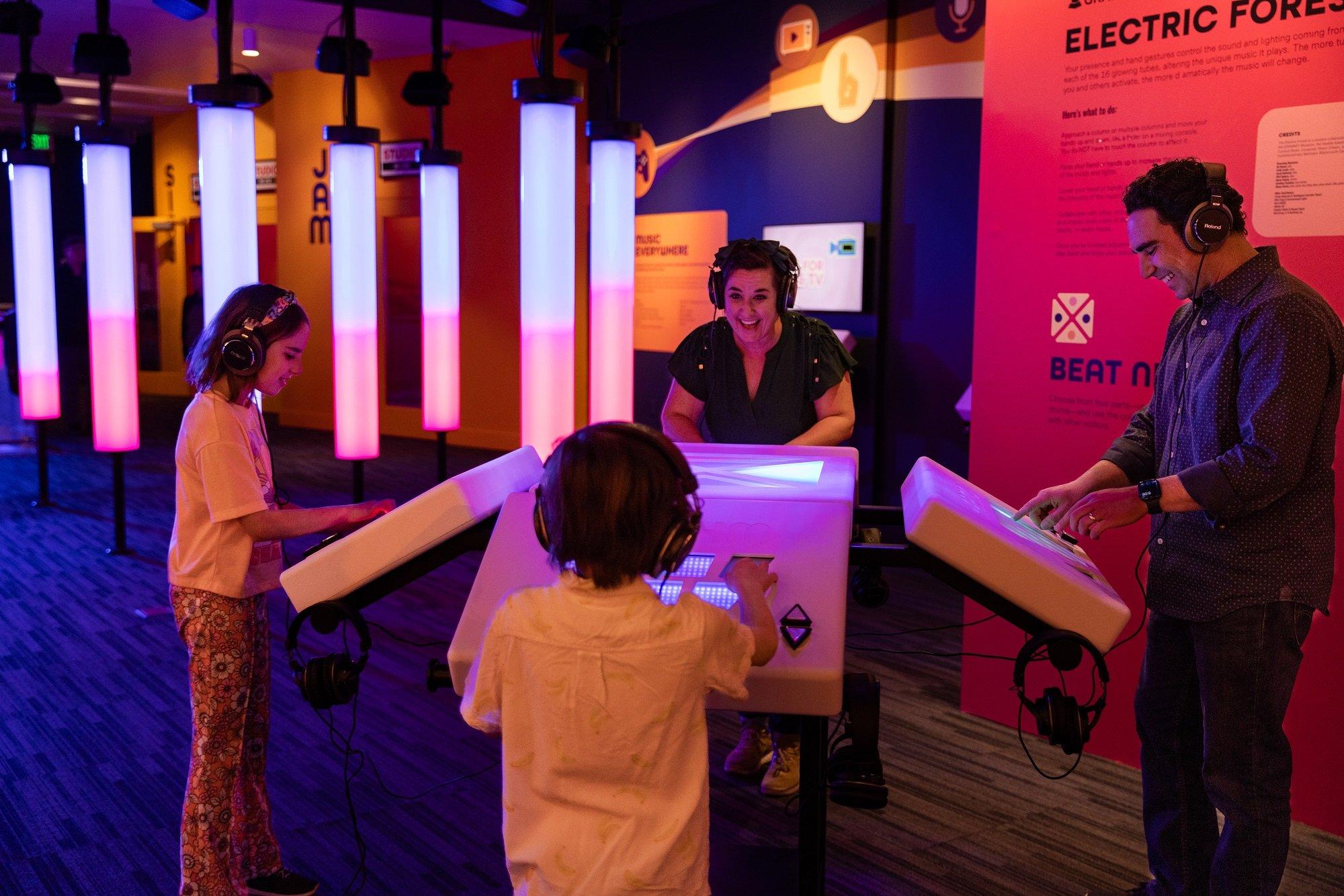
Feature
How The GRAMMY Museum Is Expanding Its Mission In 2025From free admission for visitors under 17 to expanded GRAMMY Camp locations and new exhibits, all signs point to the GRAMMY Museum having a stellar — and highly impactful — 2025.
Lily Moayeri
|GRAMMYs/Mar 26, 2025 - 01:13 pm
The GRAMMY Museum had a big year in 2024. The Museum continued to showcase groundbreaking and thought-provoking exhibitions, and explore new partnerships.
Currently on display at the Downtown Los Angeles space are Luther Vandross: Artistry and Elegance, which explores the R&B legend’s career, and over 150 works by Bay Area photographer Jay Blakesberg,RetroBlakesberg: The Music Never Stopped. The GRAMMY Museum’s annual crowd pleaser, On the Red Carpet is also on display, featuring Taylor Swift’s white strapless Schiaparelli dress worn to last year’s GRAMMY Awards.
In addition to hosting dozens of exciting events in the Museum's intimate Clive Davis Theater, the GRAMMY Museum featured 28 artists in its "A New York Evening With..." public programming. Taking place at venues throughout Manhattan and Brooklyn, these programs are made possible through the Dawn and Brian Hoesterey Family Foundation.
And while 2024 was stellar, all signs point to the institution having an even bigger year in 2025.
The big attraction so far in 2025 is the GRAMMY Museum’s newest permanent exhibition, the hands-onSonic Playground. Launched in February, the exhibit is "a truly one-of-a-kind music making experience," according to the GRAMMY Museum’s President and CEO Michael Sticka. The interactive exhibition is, in part, aimed at attracting younger music lovers, who can now visit the GRAMMY Museum for free.
The GRAMMY Museum's public programming is also continuing in earnest. March sees special performances by GRAMMY nominees Japanese Breakfast and Anoushka Shankar, plus rising star Nubya Garcia.
The GRAMMY Museum’s reach, particularly through its education initiatives, is growing exponentially, most notably with the expansion of GRAMMY Camp to three cities: its homebase of Los Angeles, and as of this summer, Miami and New York.
Below take a look at how the GRAMMY Museum is expanding its mission in the upcoming year.
The GRAMMY Museum Encourages Young Visitors With Free AdmissionOn Jan. 25, 2025, the GRAMMY Museum kicked off free general admission for visitors ages 17 and under. This policy, which is made possible by Campaign for Music Education, is a significant one for the GRAMMY Museum.
"The core of our mission is to expose to as many people as possible as much music as possible and to do so in an educational and engaging way," says Sticka. "The obvious way to do that was to remove any barriers that might exist preventing us from achieving our mission. By doing just that, the significance for the museum will be seen and felt in the impact we have through welcoming more young people to our galleries."
The GRAMMY Museum anticipates its annual numbers will double as awareness around the free admission policy for young people grows. Museum officials expect the new program to draw in more school field trips, as well as attract families who can experience the Museum at a lower overall price point.
To meet the increasing numbers of young people, there are plans for more interactive exhibitions similar to Sonic Playground. "We want to be the most interactive museum in L.A. as a way to differentiate us from other cultural institutions," says Jasen Emmons, the Museum’s Chief Curator and VP of Curatorial Affairs.
Hands-on experiences provide great learning opportunities and make for a memorable museum experience so we’re planning to include more interactives in future exhibits, including one about music and video games in the next year."
Sonic Playground Brings Out the Music Maker In EveryoneThe GRAMMY Museum’s most recent permanent exhibition, Sonic Playground, opened on Feb. 14, 2025. tHE interactive and immersive experience encourages visitors to touch, play, learn and create.
"With the museum now being free for everyone 17 and younger, we knew the museum needed to be more interactive so it would be exciting and relevant to younger audiences," says Emmons. "We created Sonic Playground as an immersive gallery that invites all our visitors to play music, regardless of their music skills or knowledge."
He continues, "We want to inspire visitors to tap into their musical creativity and become more astute listeners by making music themselves. If you make your own beats in Sonic Playground, I promise you’ll listen to drum tracks in a new way."
Learn more:At The GRAMMY Museum's 'Sonic Playground,' Art Becomes Interactive
The exhibition, which occupies the second floor of the Museum, has 17 interactive stations designed for shared experiences. These stations are sectioned into four parts: Moonmakers focuses on the intersection of sound and screens featuring the music/light/technology installation, Electric Forest. Songbuilders Hub guides users on music production with the assistance of virtual hosts such as H.E.R., Jimmy Jam and Prince Paul. The Roland Stage is a performance space equipped with guitars, Roland RD Stage keyboard, AX EDGE keytar and V-drums for percussion. The Soundtrax Career Wall highlights the myriad job opportunities in the music industry.
In the brief time it has been open, Sonic Playground has changed the museum going experience. According to Emmons, "Visitors are making music together! They’re also discovering unknown talents in one another, from a young daughter who has incredible rhythm, a mom who can really belt, or a dad who hits a drum kit like Travis Barker. Seeing music connect people of all ages has been the most rewarding outcome."
"Every Month Is Education Month"Education is a cornerstone of the Vice President of Education and Community EngagementArin Canbolat puts it best: "Every month is education month for the museum." This is apparent in the museum’s ongoing education programming and outreach to schools and music educators, which ramps up even more during March, the official Music in Our Schools Month.
Applications for the Museum’s first GRAMMY Camp (one of three, a first for the longstanding summer music education program), which will be held in Miami this June, are currently being adjudicated. Workshops are being planned and designed for spring professional development sessions for music teachers. Plus, the Museum is hosting multiple workshops for schools throughout Music in Our Schools Month.
The Recording Academy and GRAMMY Museum have recognized music educators with the Music Educator Award for the last decade. "The recognition of music educators through the Music Educator Award has had a profound impact on their work at their school sites," says Canbolat. "This award not only validates their dedication and influence but also elevates the importance of music education within their schools and communities."
This year’s recipient is the Tennessee-based choir teacher, Adrian L. Maclin who serves as his high school’s director of choirs as well as being part of the Memphis-Shelby County School District’s music leadership team and sitting on the boards of the West Tennessee Vocal Music Educator Association and the Tennessee Chapter of the American Choral Directors Association.
The Award is more than a shiny piece of metal. "By shining a national spotlight on [music educators’] work, we know that the Music Educator Award boosts morale, inspires students, and garners greater support from administrators, parents, and local organizations around music education to ultimately increase funds and expands music programs to provide students with new opportunities," says Canbolat.
GRAMMY Camp Expands To Support Stars In The MakingGRAMMY Camp, the week-long, music-focused summer program that gestated superstar GRAMMY winners like Billie Eilish, Jack Antonoff and Maren Morris, will expand beyond its homebase of Los Angeles to New York and Miami in 2025 The sought-after opportunity, which celebrates its 20th anniversary this year, offers a variety of career tracks from the creative such as performance and production to music business options taught music industry professionals including GRAMMY winning musicians.
The first GRAMMY Camp of 2025 will take place June 8-14 at Art House Studios in Miami. The Los Angeles GRAMMY Camp will be at the Evergreen Enterprise Experience July 13-19 and the New York GRAMMY Camp will be at Engine Room Audio July 27 - Aug. 2. Applications for this year’s GRAMMY Camp are now open at the GRAMMY Museum website.
"Expanding GRAMMY Camp opens access to top-tier music industry education for more young, aspiring professionals," notes Canbolat. "We are removing geographic and financial barriers that may have previously prevented students from participating."
Learn more:Maren Morris On 20 Years Of GRAMMY Camp & Her Advice To The Next Generation Of Music Industry Professionals
While some of the programs offered such as songwriting, vocal performance and instrumental performance in any genre are offered at all three locations, others are city-specific. For example, Miami campers can take advantage of music production with a DJ emphasis and Latin performance, New York campers can participate in musical theater and Los Angeles campers have the option of screen scoring.
"[GRAMMY Camp] expansion means more diverse voices and perspectives can be nurtured, allowing students from different backgrounds and musical influences to connect, collaborate, and learn from industry experts," says Canbolat. "It also provides hands-on, real-world experience in areas like songwriting, production, audio engineering, music business, and performance — helping students discover career paths they might not have realized existed."
GRAMMY In The Schools Ramps Up Its EffortsFor 2025 and beyond, GRAMMY in the Schools ramps up its already robust suite of programs. This past January, the GRAMMY Museum hosted its 2025 Student Showcase in partnership with the Norris Foundation at the museum’s Clive Davis Theater. Participating students also benefited from the presence of music industry professionals sharing their knowledge and providing career tips.
Three years since the establishment of the Campaign for Music Education (which includes among its chairs Billie Eilish, Dua Lipa, Bruno Mars, Shawn Mendes and Rosalía), generous donations have funded a cross section of educational programs. In addition to the free admission for young people, Campaign for Music Education also helps provide GRAMMY Signature Schools with grants and educational materials for public school music programs.
Following the expansion of GRAMMY Camp, GRAMMY in the Schools also has plans to grow in the coming years. GRAMMY in the Schools will be partnering with the Recording Academy’s Chapters to create bespoke programs in order to reach as many students as possible across the country.
Says Canbolat, "The education team has been working to create different models that can fit in various school settings to reach students and teachers better through music industry education."
Latest Recording Academy News & Initiatives

Academy Leaders On Disability Inclusivity In Music
Jul 22, 2025
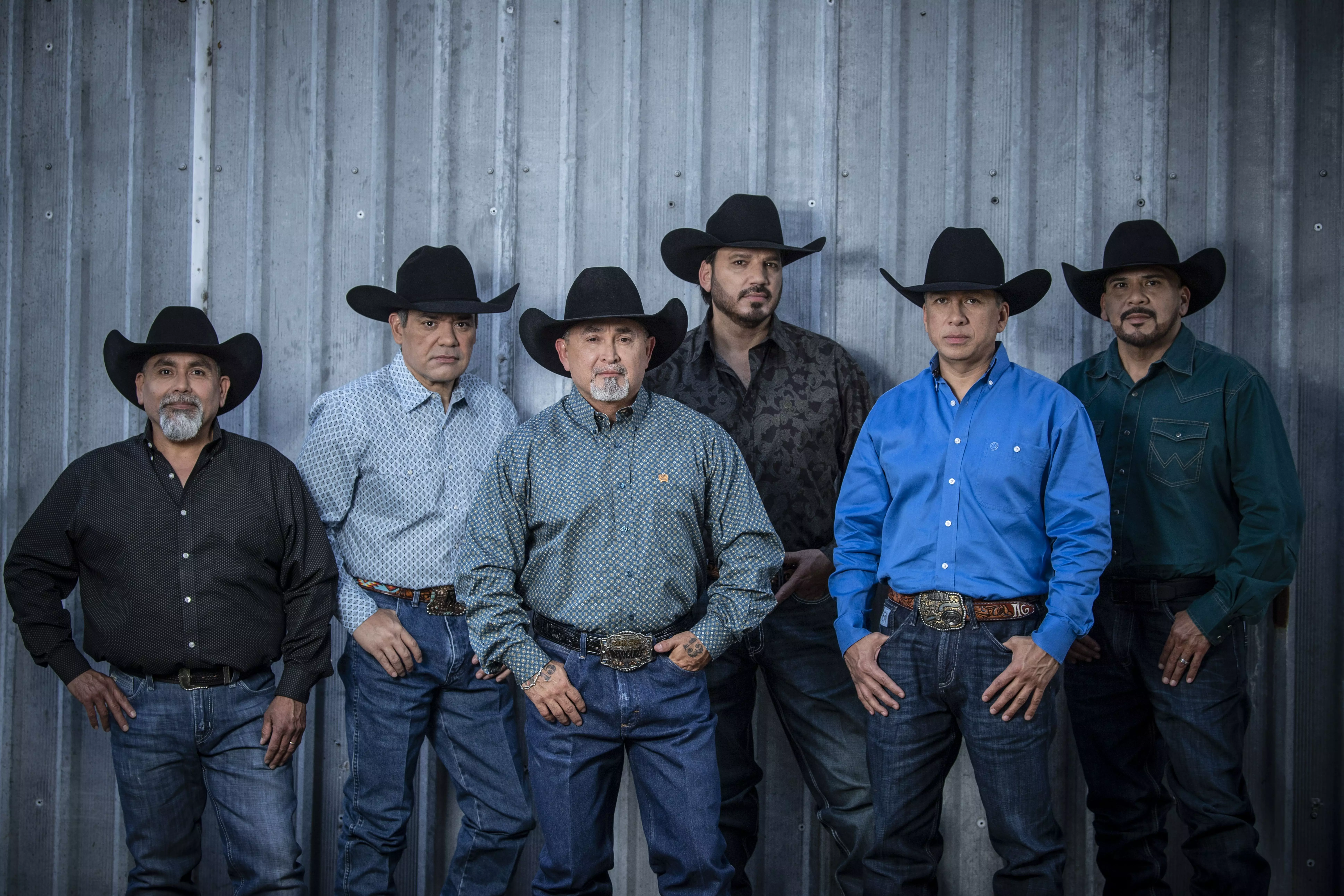
Intocable Support Latin GRAMMY Cultural Foundation
Jul 18, 2025
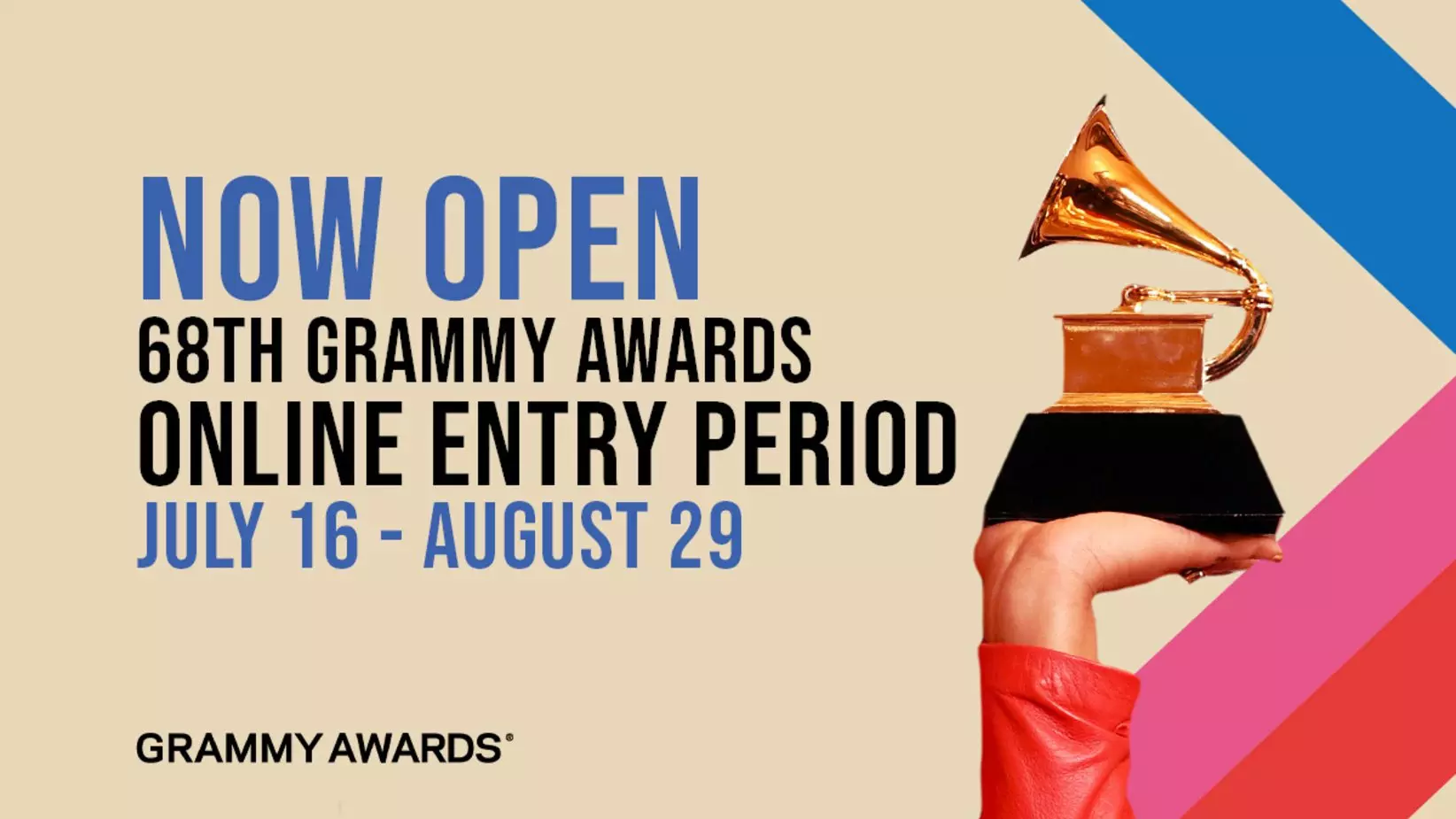
How To Submit Your Music For The 2026 GRAMMYs
Jul 16, 2025
Read More
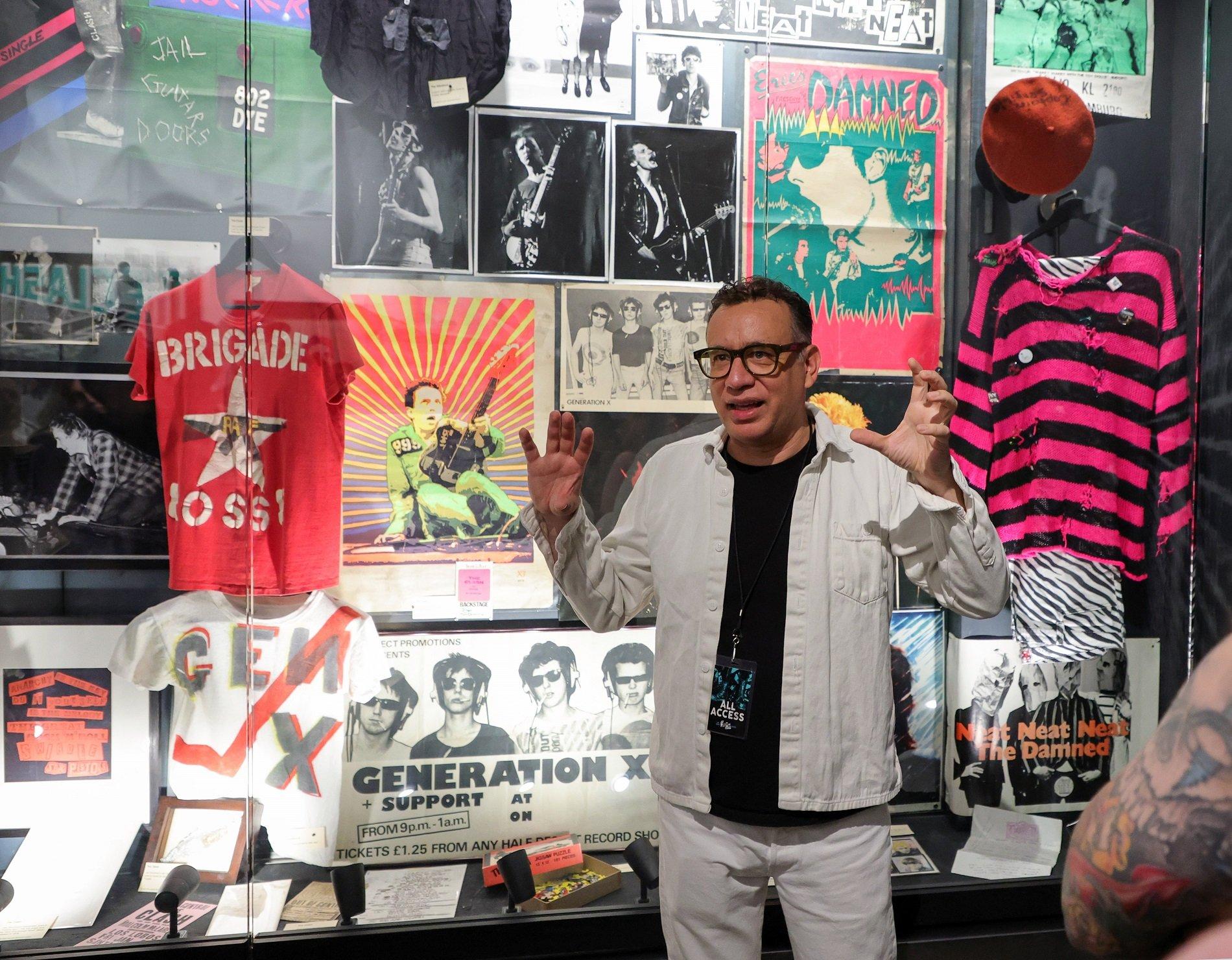
Fred Armisen leads a guided tour at the Punk Rock Museum
Photo: Ethan Miller/Getty Images
List
12 Museums That Celebrate The History & Legacy Of MusicFrom Seattle's MoPOP to Washington, D.C.'s Go-Go Museum and the Punk Rock Museum in Vegas, museums across the country celebrate and educate visitors on a variety of genres, artists, and regional sounds.
Gary Moskowitz
|GRAMMYs/Mar 10, 2025 - 05:34 pm
In 1965, as legendary trumpeter, singer, and bandleader Louis Armstrong was celebrating his 65th birthday and 50 years of making music, his hit song "Hello Dolly" had beat out the Beatles on the pop charts and earned him a GRAMMY award. Countless journalists wanted to speak with him to document the iconic American musician.
"I had a wonderful experience for a man who came up from New Orleans selling newspapers and who just wanted to blow the horn," Armstrong told Downbeat Magazine that year. "The people put me in my seat, and I’ll never let them down. And there’s no problem: they love music, and I love music too."
But how do you memorialize a musical legend like Louis Armstrong for future generations? One magazine article won’t do the trick. That’s where music museums come in.
Luckily, curators and archivists have preserved music, ephemera and other items from a wide range of musical genres, artists, and regions. Those efforts are ongoing and expanding, too: The Hip-Hop Museum in the Bronx, New York — the birthplace of the genre — is set to open in 2026, but has hosted hip-hop related events, posted newsletter updates, and facilitated educational programming in the past few years. The International Salsa Museum is similarly looking for a home in New York, but has hosted educational pop-up events on historic figures in the genre.
In celebration of Music In Our Schools Month, take a look at some unique music museums that work to preserve and breathe new life into important pieces of musical history and music culture.
The Louis Armstrong House MuseumQueens, New York
By the time he passed away in 1971, the beloved American jazz artist and his wife, Lucille, had developed quite a collection of Armstrong's life in music. The couple recorded 650 reel-to-reel tapes of him talking and put them in hand-decorated boxes; they added some 5,000 photographs to scrapbooks, collected 1,600 music recordings, 270 sets of band parts, 12 linear feet of papers, letters and manuscripts, five trumpets, 14 mouthpieces, and 120 awards and plaques.
These items and more are housed at the Louis Armstrong House Museum, a three-building campus that holds many more donated items, newspaper and magazine stories, as well as oral histories of people who lived in the local Queens neighborhoods who have first-person accounts of Louis and Lucille Armstrong during the time they lived there.
The Go-Go Museum & CafeWashington, D.C.
This recently-opened, intimate, 8,000 square foot museum tells the story of a D.C.-grown genre: go-go. The proto-hip-hop genre evolved in the 1970s amidst gentrification of D.C.'s predominantly Black Anacostia neighborhood, and blends Afro-Latino percussion on cowbells and conga drums with funk, jazz, hip-hop and R&B, and call-and-response interactions between performers and audiences.
Read more: Bustin' Out With D.C. Go-Go: How DMV Hip-Hop Grew From A Unique Local Sound
The Go-Go Museum dives deeper into the culture behind the genre, curating live performances alongside interactive exhibits. Visitors are greeted by a talking hologram of go-go star and actor Anwan "Big G" Glover, which utilizes artificial intelligence to answer questions about go-go music.
Patsy Cline & Johnny Cash MuseumsNashville, Tennessee
Johnny Cash is one of the most influential artists of all time for both his sound and attitude. The 13-time GRAMMY winner and Lifetime Achievement Award recipient performed country, rockabilly, folk, and gospel, and gained notoriety late in his career for melancholy acoustic covers of Depeche Mode, Sting, and Nine Inch Nails.
Visitors to the Johnny Cash Museum in Nashville view costumes, cowboy boots, guitars, gold and platinum records, handwritten song lyrics, and a piece of the wall from the home the "Man in Black" shared with his wife, June Carter Cash.
On the second floor of the same building is the Patsy Cline Museum.. The country music singer died at just 30 years old in a plane crash, but left behind three studio albums and hit songs in the country and pop music charts,. Among her memorable works are "Walkin’ After Midnight" and "Crazy," a song written by Willie Nelson which the Library of Congress inducted into the National Recording Registry.
The museum holds a wide collection of memorabilia from different periods of Cline’s life, as well as clips of live performances, handwritten letters, and costumes that were designed by Cline and sewed by her mother.
Punk Rock MuseumLas Vegas, Nevada
NOFX bassist/vocalist Fat Mike had been gathering punk artefacts for a home punk museum called "The Paultry Punk Rock Museum" — but as the collection grew, he realized he was going to need more space.
Fat Mike's small home collection evolved into an idea to open a 1,200-square-foot punk store in Las Vegas, which then evolved into a 12,000-square-foot punk rock museum in Las Vegas that opened on April 1, 2023. Museum investors include guitarist Pat Smear (guitarist of the Germs, Nirvana, and Foo Fighters), as well as Warped Tour creator Kevin Lyman and skateboarder Tony Hawk.
Read more: Inside The Punk Rock Museum In Las Vegas: "A Mecca For Memories"
Punk musicians like Jennifer Fynch of L7, Norwood Fisher of Fishbone, and Mitch Harris of Napalm Death host guided tours of the collection, which includes show fliers, clothing, and photos. Visitors can also go into the "guitar goom" and play through amps previously used by bands like Pennywise and Sick Of It All.
Read more: How Las Vegas Became A Punk Rock Epicenter: From When We Were Young To The Double Down Saloon
Musical Instrument MuseumPhoenix, Arizona
The Musical Instrument Museum in Phoenix was created with a mission to focus on instruments played every day by people worldwide. The museum’s collection includes thousands of instruments from more than 200 countries and territories around the world; many of the instruments on display are rare, historically significant, or part of distinctive musical cultures.
Visitors who explore the museum’s Experience Gallery can play a range of instruments, including a West African djembe, a theremin, a Peruvian harp, and a Javanese gamelan.
Video footage of musical performances show instruments played in their original contexts. Visitors can watch GRAMMY award-winning Iranian musician Kayhan Kalhor play a rare, ornate kamancheh stringed instrument, and also explain the instrument’s significance. Roughly 200 artists perform each year in the museum's 300-seat theater.
The GRAMMY MuseumLos Angeles, California
At the newly opened Sonic Playground at the GRAMMY Museum in Los Angeles, virtual hosts like H.E.R., Jimmy Jam and Prince Paul guide visitors through the music production process by showing them how to create beats, mix samples, and experiment with instruments. Visitors can also get into the action, jumping "onstage" to play guitars, keyboards, a keytar, and percussion.
Founded in 2008, the museum regularly hosts interviews, panels and screenings in its 200-seat Clive Davis Theater. Upcoming events in L.A. include an evening with comedian and musician Margaret Cho and Global Spin Live with JO1. At the Museum's New York location, March will see moderated discussions with Anoushka Shankar, Japanese Breakfast and others.
Visitors to the Los Angeles museum can view past GRAMMY performances — such as Taylor Swift’s 2010 GRAMMY Award for Best Country Song — and peruse musical artefacts like Shock G’s nose and glasses from hip-hop group Digital Underground, or one of Flavor Flav’s clock necklaces.
Motown MuseumDetroit, Michigan
"Hitsville U.S.A." — the nickname of Motown's first headquarters and recording studio in a house in Detroit — famously combined elements of gospel music with jazz and other influences to create "the sound of young America." Today, that original house has transformed into the Motown Museum. The historic studio now houses costumes, photographs, and memorabilia dedicated to Motown artists like the Temptations, Smokey Robinson, and the Supremes.
Learn more: 10 Unsung Heroes Of Motown: The Funk Brothers, The Velvelettes & More
The museum also hosts events and programming aimed at singers, spoken word artists, and local schools. Motown Museum also serves as a digital archive for its artists, curating a blog that features updates on a wide range of living artists such as the Spinners, Martha Reeves, and Claudette Robinson of the Miracles, and posts tributes to legends like Motown artist Edward Pickens and Quincy Jones.
Read more: 5 Ways Berry Gordy And Smokey Robinson's Philanthropic Efforts Supported The Music Community & The World
The National Hip-Hop MuseumWashington, D.C.
Located near Howard University in Washington, D.C., the National Hip-Hop Museum offers a collection of hip-hop memorabilia, from Adidas sneakers worn in the film Do The Right Thing to a Wu-Tang Clan bomber jacket and signed Queen Latifah records. The museum’s interactive House of Hip-Hop exhibit highlights painters, photographers, digital artists, sculptors, illustrators, and other visual hip-hop artists.
Also on display at the museum is a hip-hop timeline curated by music historian Jay Quan. The timeline includes album release dates, artist birthdays, and other significant dates that help illustrate the growth and trajectory of hip-hop music and culture.
The museum also hosts live events. Glen E. Friedman, a photographer who documented hip-hop music and culture in the late '80s and 1990s, recently did a live podcast and book signing there. Earlier, Sugarhill Gang founder Master Gee has conducted live interviews with hip-hop artists like Marley Marl and Kool Moe Dee, the latter of whom recently performed with Lords of the Underground to commemorate the 40th anniversary of the film Beat Street.
Trap Music MuseumAtlanta, Georgia
The Trap Museum was one of the nation’s first to dedicate itself to Southern hip-hop and its evolution. The museum focuses entirely on trap music, a subgenre of hip hop originated in Atlanta in a significant way in the early 2000s, typically associated with 808 drum machine beats, complex, rapid-fire hi-hat rhythms, and a low-thumping kick drum sound that has gone on to inspire and influence contemporary pop and R&B artists.
Read more: A Guide To Southern Hip-Hop: Definitive Releases, Artists & Subgenres From The Dirty South
Opened by GRAMMY-winning rapper T.I. and business partner William "Bem" Sparks in 2019, the museum is set up like an escape-room, and features exhibits and artifacts highlighting Southern culture and the hip-hop music that evolved from it. A prominent fixture is a pink old-school car used to promote 2 Chainz’s 2017 album Pretty Girls Like Trap Music.
T.I wanted visitors to understand why trap music exists, so he aimed to use the museum to explain how trap music documented the aftermath of the 1980s crack epidemic in the South, and how the music and culture impacted mainstream pop culture. The Trap Music Museum was initially supposed to be open for just a few months, but more than 2,500 people signed an online petition to keep it open..
New Orleans Jazz MuseumNew Orleans, Louisianna
Located in an old U.S. Mint building adjacent to New Orleans’ historic French Quarter, the New Orleans Jazz Museum’s origins date back to the 1950s.
Museum curators aim to celebrate the history of all forms of jazz music and culture through interactive exhibits, educational programming, research facilities, and live musical performances. Their goal is to promote jazz as a global phenomenon and one of the most innovative, pivotal art forms in world history.
Drummer Stanton Moore has hosted "Spirit of New Orleans" drum camps at the museum, and artists like the Treme Lafitte Brass Band perform regularly in a weekly "Balcony Courtyard" concert series at the museum, which recently completed a large renovation of its third-floor performance center.
The Jazz Museum houses two archives on site, the New Orleans Jazz Club Collections and those of the Louisiana Historical Center. Archive materials include instruments — Louis Armstrong's first cornet and instruments played by other jazz greats like Sidney Bechet and Dizzy Gillespie — as well as pictorial sheet music, roughly 12,000 photographs, records, and tapes, such as a 1917 disc of the first jazz recording ever made.
MoPOP: Museum of Pop CultureSeattle, Washington
Originally founded in 2000 as the Experience Music Project, Seattle’s Museum of Pop Culture champions pop culture by preserving its history and helping shape its future, through educational programming, events, and exhibits.
Museum curators have recently hosted an Indian film festival and events focused on Asian comics, and have hosted programming focused on science fiction, horror, video games, and fantasy.
The museum houses 85,000 pieces, including a large collection of hand-written lyrics and personal instruments — among them, splintered pieces of Jimi Hendrix's Fender Stratocaster and one of Bo Diddley’s custom-made guitars — as well as photographs that celebrate, among others, Seattle-area groups like Nirvana.
Artefacts tied to the genre of grunge, largely associated with the Pacific Northwest, are also housed at the museum, as are collections dedicated to hip-hop — a white linen shirt worn by Notorious B.I.G, turntables used by Grandmaster Flash — and science fiction, a collection that includes an outfit worn by actress Darryl Hannah in the 1982 film Blade Runner.
More Museums & Music Education News
10 Hall Of Fames To Visit This Spring
Mar 26, 2024
See JO1 & Others At The GRAMMY Museum In March
Feb 27, 2025
10 Iconic Recording Studios You Can Tour
Nov 28, 2023
2025 Music Educator Award Winner Announced
Read More
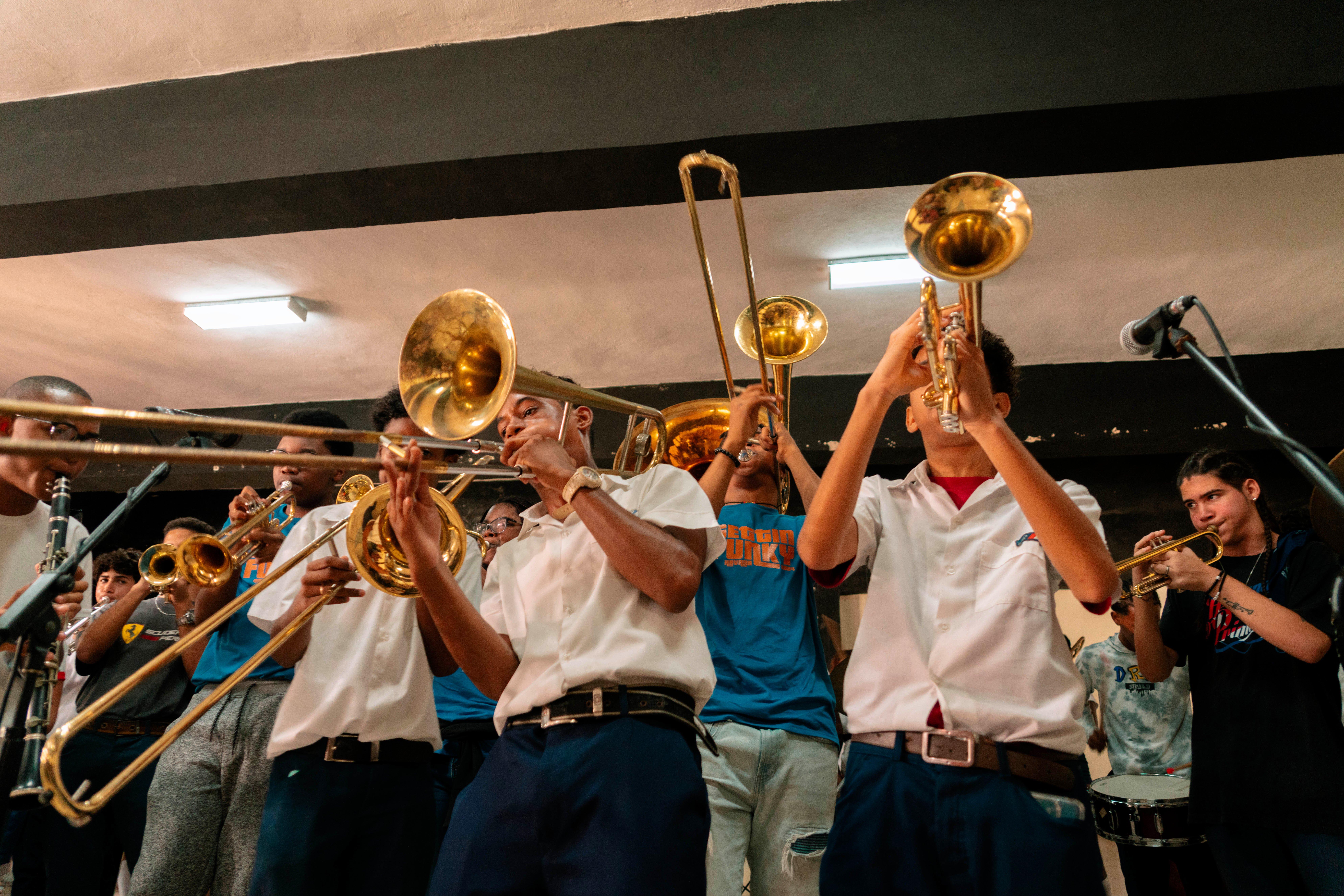
Cuban music conservatory students perform during Getting Funky In Havana 2024
Photo: Eduardo Reyes Aranzaez
Feature
At Getting Funky In Havana, Young Musicians Feel The Power Of Cross-Cultural ConnectionAn annual program organized by the Trombone Shorty Foundation and Cimafunk, Getting Funky In Havana explores the deep connections between Cuba and New Orleans — and provides student musicians with once-in-a-life-time learning opportunities.
Jessica Lipsky
|GRAMMYs/Mar 25, 2024 - 08:34 pm
It’s sweltering inside the Guillermo Tomas Music Conservatory, a primary school in Havana’s Guanabacoa neighborhood, where American visitors enjoy what will likely be the best school recital they'll ever see.
A series of teen and tween musicians — some in trios and quartets, others in larger ensembles — are playing a mix of Latin jazz, orchestral overtures and even a rousing rendition of the Ghostbusters theme. During an interpolation of Aretha Franklin's "Think," three young horn players burst to the front of the group in a competitive but friendly battle of brass.
The performance is the centerpiece of Getting Funky in Havana, a four-day music and cultural exchange program developed by GRAMMY-nominated Cuban funk artist Cimafunk, GRAMMY-winning New Orleans multi-instrumentalist Trombone Shorty's namesake foundation, and Cuba Educational Travel. Now in its third year, Getting Funky brought nearly 200 American music lovers, artists and students to Havana in January to explore the deep connections between Cuban and New Orlenian sounds through a series of performances, educational activities and panels.
"Cuba and New Orleans have a long line of influence, and we have special things that happen in both places that people can hear through our music," Trombone Shorty, born Troy Andrews, tells GRAMMY.com. "Passing along music and knowledge is…how the music's staying alive. I always try to tell the kids, learn everything that came before you, but also be very innovative."
While there are many conservatories in Havana, Guillermo Tomas was chosen in part for its similarities to New Orleans' Treme neighborhood, where many of the Trombone Shorty Foundation students live. Guanabacoa is "probably the deepest Afro-Cuban cultural neighborhood" in Havana, says Foundation Executive Director Bill Taylor.
Those shared roots and experiences were on display during several capstone concerts, which were also open to Havana residents. At a massive outdoor concert blocks away from Havana's famous Malecón, Getting Funky attendees enjoyed performances from Cuban salsa legends Los Van Van, reparto star Wampi and Shorty's Orleans Avenue. At a pinnacle performance the day before, more than 30 artists gathered at Havana arts hub La Fabrica for a sold-out international jam. Shorty, Big Freedia, Ivan Neville, percussionist Pedrito Martinez, PJ Morton, Tarriona "Tank" Ball, drummer Yissy Garcia and others joined forces with Cuban artists Reina y Real and X Alfonzo to create an unceasing groove.
Cuban and American students perform outside Guillermo Tomas┃Eduardo Reyes Aranzaez
While the concerts certainly brought the energy to a fever pitch, the beating heart of Getting Funky is its mission of music education. Ten members of the Trombone Shorty Foundation's brass band traveled to Cuba, where they performed at Getting Funky's opening night party and several other events. Throughout the week, the New Orleans students shared stages with their Cuban counterparts, learning each others' musical idioms and finding common ground.
"So much of the music [we hear in New Orleans comes] from Africa through the Caribbean to New Orleans, then spreading throughout the United States. When our students connect with those [Cuban] students, there's a natural, symbiotic connection that takes place," Taylor says.
High school senior and sax player Dylan Racine called the trip — his first time out of the country — a life-changing experience. "I learned so many new skills on this trip, including how to network, how to collaborate with young people from a different culture than me, and more," he says via email. Drummer and pianist John Rhodes, another senior, added that the experience was invaluable.
"I was able to interact with another culture and understand other young people through music. Although we couldn't speak the same language, we understood each other musically," he writes.
Both Cuba and New Orleans' unique musical cultures require constant innovation to survive, Taylor adds. "You honor the past, but it needs an infusion of new life in order to thrive. Getting Cuban musicians together with New Orleans musicians infuses a shot of energy into both of those musical styles."
The trip also put students from both countries in contact with working musicians, whose own perspectives were expanded by the experience.
"Music education and pedagogical expertise is so important. We need the next level to come up and be dope, just like we are," says trumpeter Keyon Harrold, whose work has taken him from sessions with Beyoncé to the 2024 GRAMMYs. This was Harrold’s second year at Getting Funky. "It's even more visceral and engaging to actually see these kids at the age of 10, 11, 12, and to know that in five years they're going to be the next."
For many of the musicians who attended, Getting Funky was an inspirational experience that furthered their existing work as well. "I perform for a living, but performing and playing with [students] is super dope. [Their energy is] clean," says GRAMMY-winning producer, rapper and mentor Deezle. "If I can in any way help to guide their path away from the pitfalls that I've encountered and endured, I would love to do that."
Legendary singer/songwriter Ivan Neville said he was blown away while watching young musicians from different worlds performing together. "This music was making their souls feel so good. I know music is good for the soul, but it was another level that I saw."
Fabio Daniel (center) and members of Primera Linea, or "first line"┃Eduardo Reyes Aranzaez
Since Getting Funky In Havana was established in 2020, the program has had a measurable impact on Cuban students' lives. In 2023, several young Cuban musicians traveled to New Orleans during JazzFest, where they visited Shorty’s studio and performed together at legendary venue Tipitina's. When the group returned home, they formed their own brass band, Primera Linea.
"This band is working; they are playing many places in Havana and that's thanks to the project. They were so into the satisfaction of [feeling] that they are valued," says Erik Alejandro Iglesias Rodríguez, who records as Cimafunk. "They are learning good quality things in terms of human relationships and in terms of music. [The program is] something that changes their mentality and lets them know that they can make it."
While Cuba harbors an incredible amount of musical talent, "making it" as a musician in the country comes with a unique set of challenges. The country's shrinking economy, high rate of inflation and low monthly incomes have 62 percent of Cubans reporting that they "struggle to survive" financially, according to a 2023 survey. Purchasing a professional calibur instrument, which may cost hundreds or thousands of U.S. dollars, often comes with great sacrifice.
It's an emotional day back at the Guillermo Tomas, where 10 of the school's top students will be awarded an instrument.
"An instrument is not something you can buy in a store," says Amanda Colina González, an art historian and one of the trip guides, who studied saxophone in conservatory. Colina González, like the majority of students, was given an instrument to play for the duration of her studies but had to return it to her school upon graduation. Remembering that moment brought tears to her eyes.
Because of its high cost and the possibility of leading to international travel, owning their own instrument can truly change a young musician's life. Getting Funky has donated approximately 50 instruments to Cuban students over three years of programming.
Fifteen-year-old Daniela Hernandez was awarded a trombone for her skill and dedication to music outside of school. Harried and teary-eyed after the recital, she shared her happiness and pride for being able to play with musicians who she's long admired. She plans to use her new trombone to study and will "take it with me everywhere."
Daniela and classmate Fabio Daniel (who received a trumpet during the first edition of Getting Funky in Havana in 2020) joined Trombone Shorty onstage at Getting Funky, performing for more than 15,000 people. Several of their friends and classmates brought their instruments to the concert — the largest held in Cuba in the last four years — and played back at the band from the crowd.
View this post on Instagram
A post shared by Trombone Shorty Foundation (@shortyfoundation)
"Cuban musicians really enjoy playing and making other people feel joy through music,” Daniela says. Fellow trombone player and awardee Cristian Onel León says it's important to play for people outside of Cuba, and enjoys teaching people about his country's rhythms and keys. "I’m [also] learning other forms of playing, that aren’t mine. And it feels good,” he adds.
The program's instrument donation is spearheaded by the long-running nonprofit Horns To Havana, and supported by the Gia Maione Prima Foundation and private donors. Tickets purchased to attend the program also fund its efforts; Taylor says 2024's Getting Funky raised approximately $50,000. The Trombone Shorty Foundation hopes to continue the annual event, and expand into different countries; a 2025 Havana trip is already in the works.
For Rodríguez, who recently moved to New Orleans, the effect of this musical exchange is tangible. He's noticed more musicians who are open to collaborating across borders, and is working on new music with artists who have attended Getting Funky in previous years.
"Just jamming changes everything," he says. "That changes the minds of people; that changes the sound."
The connections made during Getting Funky have led to a variety of opportunities for students on both sides of the Gulf of Mexico. Foundation alto saxophonist Jacob Jones credits the trip for broadening his way of thinking while playing music; Deezle says he wants to get Cuban trumpeter and bandleader Fabio Daniel on a track; Primera Linea may perform at San Francisco's Outside Lands festival in August.
"To be able to facilitate that, and give to these young musicians of Cuba, is unbelievable," Andrews says of the program. "It's just a blessing to be able to be a blessing and help out the next generation, and help those musicians see a brighter future."
Venezuelan Immigrant Musicians In The U.S. Carry Sound, Sentiment & Love For The Country They Left Behind